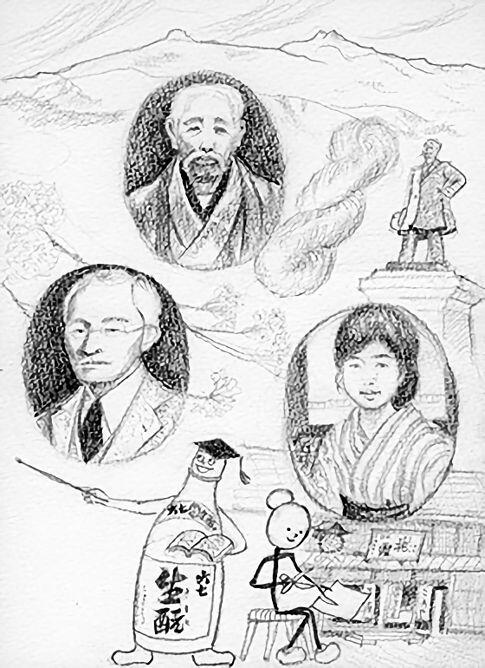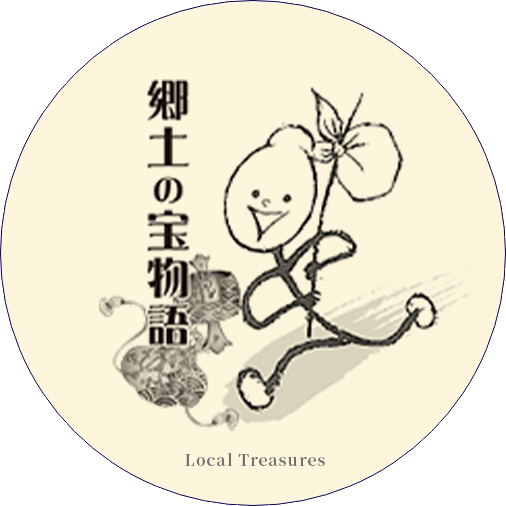| Yeast |
“Kimoto, our hometown Nihonmatsu is rich in great men and women.” |
| Kimoto |
“We lost the Boshin War (1868-69), but after that people from Nihonmatsu played an important role in the modernization of the country. Let me first introduce Osamu Yamada (1841-1921), whose statue stands in the castle park of Nihonmatsu. He set up our country’s first private silk reeling factory.” |
|
 |
| Yeast |
“The Nihonmatsu Silk Company was established in 1873, one year after the Tomioka Silk Mill in Gunma prefecture which is now a World Heritage Site. Moreover, it was the first ‘limited company’ set up in Japan. Mr Yamada was very successful and even went to the U.S. to set up a branch in New York. From samurai to international entrepreneur!” |
| Kimoto |
“He really helped revitalize Nihonmatsu after it had incurred damage in the Boshin War. Thanks to the advice of Yataro Iwasaki, the founder of the Mitsubishi conglomerate, his attention was drawn to raw silk, and he adopted the limited company form thanks to the backing of Eiichi Shibusawa. Although based far from the capital, he was closely connected with those famous persons who were in the vanguard of the economy.” |
| Yeast |
“The establishment of the silk reeling factory was big news in the whole country, and it saw many visitors on a daily basis. The factory was also part of the official tour of Northeastern Japan undertaken by the Meiji Emperor, and it received high praise.” |
| Kimoto |
“Mr Yamada continuously strove to improve quality, and as a politician he was devoted to Nihonmatsu. After his death, the factory was unfortunately lost in a fire, but his merits were very high.” |
| Yeast |
“We also have great forerunners in the field of scholarship, such as the historian Kanichi Asakawa (1873-1948), who became the first Japanese to teach at Yale University. Dr Asakawa actively made proposals for Japan’s foreign policy, he was the opposite of a scholar in an ivory tower.” |
| Kimoto |
“Dr Asakawa graduated from Asaka High School. Today there still remains an ‘Asakawa Cherry Tree.’ The story goes that Asakawa every day memorized two pages from his English-Japanese dictionary, after which he would tear out the pages and swallow them. In the end, he was only left with the leather cover of the dictionary and he buried that at the foot of the cherry tree. He was so talented that he was even called ‘the God of Scholarship.’” |
| Yeast |
“After he graduated from Waseda University, the university’s founder Shigenobu Okuma and the journalist and historian Soho Tokutomi helped him to study in the United States. He graduated with honors from Dartmouth College, then went for his Ph. D. research to Yale and after that even became Professor at Yale.” |
| Kimoto |
“But it gets even more interesting. Until the war between Japan and Russia, he agreed with the direction of Japanese foreign policy, but later he started sounding the alarm bell. Just before the war between Japan and the United States began, he urged that a personal letter be sent from president Roosevelt to the Japanese emperor, and even wrote a draft for it. Unfortunately, nothing came of it, but this shows how strongly he promoted peace and did his best for his country. To honor his achievements, at Yale University the Asakawa Garden was set up.” |
| Yeast |
“Our forebears were really great! It is strange that Dr Asakawa is not more famous… But talking about famous persons, in Nihonmatsu we also have Chieko Takamura (1886-1938), known from the poetry collection Chieko’s Sky!” |
| Kimoto |
“Chieko was born into the wealthy Naganuma sake brewery family in Nihonmatsu. She graduated from Japan Women’s University and became a Western-style oil painter in Tokyo – something rare for a woman at that time. She also made the cover illustration for the first issue of the feminist literary magazine Bluestocking.” |
| Yeast |
“And then she met the poet Kotaro Takamura (1883-1956)! Although Chieko later suffered from mental illness due to the bankruptcy of her family and an impasse in her artistic development, thanks to Chieko’s Sky the story of her pure love for Kotaro Takamura has become immortal.” |
| Kimoto |
“Thanks to the poem about the ‘true sky of Nihonmatsu,’ Nihonmatsu was put in the spotlight (‘The blue sky that appears every day / High above Mount Adatara / That’s what I call the true sky, says Chieko.’). Do you know that when the film Chieko’s Sky (1967) was made with the famous actress Shima Iwashita in the main role, the storehouse of the Daishichi Sake Brewery was filmed as a stand-in for the brewery of Chieko’s family?” |
| Yeast |
“That’s new to me!” |
| Kimoto |
“The Chieko Takamura Memorial Hall now is an important tourist spot. I hope that everyone who visits Nihonmatsu will go there!” |





